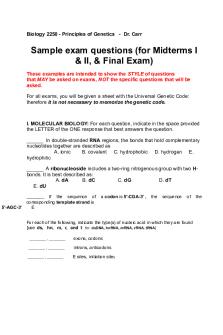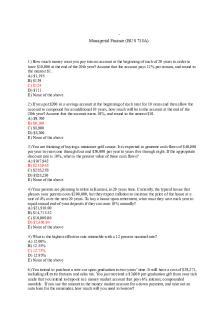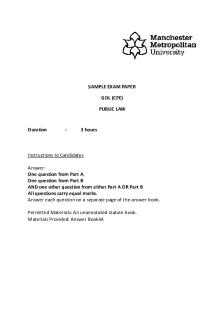IRMER Exam questions PDF

| Title | IRMER Exam questions |
|---|---|
| Course | Clinical Dental Practice 2 |
| Institution | University of Plymouth |
| Pages | 13 |
| File Size | 67.3 KB |
| File Type | |
| Total Downloads | 58 |
| Total Views | 138 |
Summary
These are all 50 questions for the IRMER radiography exam all students have to pass (with 100%) in order to take radiographs on clinic. These questions are set and do not change but only a percentage are asked in the exam. ...
Description
1.
In an intra-oral X-ray set, X-ray photons are produced at... 1. The cathode 2. The filament 3. The tungsten target 4. The focusing cup 5. The aluminum filter
Code: 2.
1501 In an intra-oral X-ray set, the purpose of the aluminium filter is to....
1. Protect the operator 2. Absorb scattered radiation 3. Help create a sharper image 4. Prevent backscatter from fogging the image 5. Preferentially attenuate low energy X-rays
Code: 3.
1502 In an intra-oral X-ray set, the purpose of the collimator is to...
1. Focus the X-rays 2. Protect the operator from scatter 3. Restrict X-ray beam to chosen area 4. Absorb scattered radiation 5. Remove the lower energy radiation from the beam
Code: 4.
1503 In an intra-oral X-ray set, the High Tension (Voltage) circuit...
1. Operates at around 50,000 Volts 2. Is in the 65-70 kVp range 3. Is usually about 6.5 - 7.5 mA 4. Is usually around 65,000 kV 5. Varies according to the exposure setting
Code: 5.
1506 Compton (inelastic) scatter...
1. Operates at around 50,000 Volts 2. Is in the 65-70 kVp range 3. Is usually about 6.5 - 7.5 mA 4. Is usually around 65,000 kV 5. Varies according to the exposure setting
Code: 6.
1507 The mA current setting on an intra-oral X-ray set...
1. Is the Mega Amp current 2. Controls the number of electrons produced at the filament 3. Controls the high tension (HT) circuit for the set 4. Is usually set for each exposure by means of the control box 5. Is set higher for a bite-wing than for a periapical radiograph of an upper molar
Code: 7.
1508 In an intra-oral X-ray set, excess heat...
1. Is conducted away by the copper block 2. Is dissipated by convection in the oil surrounding the tube 3. Is caused because X-ray production is inefficient 4. Is radiated away from the outer case 5. All of the above Code: 8.
1509 Rectangular collimation...
1. Reduces the patient - dose by around 40% 2. Ensure object and receptor are in the correct relationship 3. Is mandatory 4. Helps align the tube to the film 5. Holds the film in the correct position
Code: 9.
1510 The stochastic effects of ionising radiation...
1. Have a safe threshold 2. Cause no biological damage at low doses 3. Follow a linear-quadratic relationship 4. Can result in radiation-induced erythema or burns 5. Occur as the result of chance events
Code:
1511
10. Which statement is true with regards to the paralleling intraoral technique? 1. Periodontal bone levels are poorly represented 2. It increases magnification of the image 3. It enables the beam to be centred to the film 4. It is not the technique of choice routinely 5. It is not appropriate for patients with disabilities
Code: 11.
1512 Collimation of the X-ray beam…
1. Should be circular 2. Increases the volume of exposed tissue 3. Increases scattered radiation 4. Is not necessary 5. Should be rectangular Code: 12.
1513 The deterministic or non-stochastic effects of ionising radiation...
1. Occur according to the laws of chance 2. Are dose-dependent 3. Have no threshold 4. Are independent of the amount of radiation received 5. Are concerned with the risks of inducing cancer at low doses Code: 13.
1514 The X-ray beam should be…
1. Perpendicular to the tooth and image receptor to prevent distortion 2. As close to the patient as possible 3. Produced from a large focal spot 4. Kept on for as long as possible 5. Positioned perpendicular to the floor Code: 14.
1515 The risk of developing cancer from low doses of ionising radiation...
1. Is non-existent at very low doses 2. Has a ‘dose threshold’ 3. Clearly demonstrates a hormesis effect 4. Follows the linear-no-threshold model 5. Is independent of the dose received
Code: 15.
1519 The Frankfort baseline is…
1. A radiographic plane that divides the face symmetrically from the crown of the head to the tip of the mandible 2. A radiographic term that describes normal anatomical appearances viewed on an DPT 3. A radiographic plane that extends from the external auditory meatus to the infraorbital margin 4. The relative position of the tube, cassette and patient during DPT examinations 5. A radiographic plane that bisects the first upper molar Code:
1520
16. The National Diagnostic Reference Dose for intra-oral radiology is approximately 2.0mGy. This is expressed in terms of... 1. Absorbed dose 2. Committed dose 3. Dose-width product 4. Effective dose 5. Equivalent dose
Code: 17.
1521 An X-ray of a female patient of child-bearing age...
1. Must not be undertaken if she is pregnant 2. Is prohibited under the Ionising Radiations(Medical Exposure ) Regulations unless a check is made if she is pregnant 3. Can only be undertaken if she is given a lead apron to wear over her abdomen 4. Can only be undertaken within 10 days of the last menstrual period 5. Must be undertaken in accordance with local written procedures
Code: 18.
1523 Under IRMER Optimisation ensure that...
1. The dose is as low as achievable and image quality is acceptable 2. The image quality is high 3. The patient dose is low 4. The patient dose is less than the Diagnostic Reference Level
5. The patient receives a dose at the diagnostic reference level
Code: 19.
1524 Under IRMER...
1. The Referrer must be appropriately trained 2. The Practitioner does not require theoretical training 3. The Operator must have practical training 4. Students under supervision must be trained before carrying out exposures 5. Operators do not require theoretical training Code: 20.
1527 Regarding Justification...
1. Examinations on pregnant patients are not justified 2. Justification must be carried out for every exposure 3. Examinations on children under 5 are not justified 4. Justification is not required for routine x-rays 5. Does not apply to asymptomatic exposures
Code: 21.
1528 Regarding Justification...
1. The Referrer is responsible for justifying the exposure 2. The Practitioner is responsible for justifying the exposure 3. The exposure is approved by the Practitioner and justified by the Operator 4. The Operator is responsible for justifying the exposure 5. The exposure is justified by the Referrer and authorised by the Practitioner
Code: 22.
1530 The Ionising Radiation (Medical Exposure) Regulations 2000...
1. Protect members of the Dental Team 2. Are an Approved Code of Practice 3. Are intended to protect patients 4. Place a limit on the number of x-rays a patient can receive 5. Protect members of the public
Code: 23.
1533 IRR99 requires...
1. All exposures to be restricted as far as reasonably practicable 2. All exposures to patient to be within diagnostic reference levels 3. All staff to be monitored for radiation exposure 4. Doses to patients to be recorded 5. Exposures of patients to be within Dose Limits
Code: 24.
1534 A female member of staff...
1. Must tell her employer if she is in the first trimester of pregnancy 2. Must tell her colleagues if she is more than 6 months pregnant 3. Must not work with X-ray equipment 4. Must wear a lead protective apron 5. Must inform her employer in writing if she is pregnant
Code: 25.
1535 Concerning Controlled Areas...
1. Non-classified workers are not permitted to enter Controlled Areas 2. Pregnant patients are not permitted to enter Controlled Areas 3. Are subject to written arrangements to control access 4. Access is permitted for employees only 5. Are monitored by the Radiation Protection Adviser
Code: 26.
1536 The Radiation Protection Supervisor (RPS)...
1. Is usually either the Practice Administrator or Senior Dental Nurse 2. Must be a dentist 3. Isn’t usually required in a hospital/dental school
4. Must be identified in the practice information in leaflet 5. Must have received appropriate training
Code: 27.
1537 The role of the Radiation Protection Supervisor...
1. Is to write Local Rules for the Practice 2. Is to ensure Radiation Badges are changed monthly 3. Is to ensure X-ray equipment has been regularly serviced 4. Is to ensure that Local Rules are being followed and enforced 5. Is to ensure the Register of Training is kept updated
Code:
1539
28. The absorbed dose at the cone for a mandibular molar radiograph is approximately... 1. 10 cGy 2. 0.1 Sv 3. 2 mGy 4. 25 mGy 5. 3.2 mSv
Code: 29.
1541 Bremsstrahlung or ‘braking radiation’ is...
1. The major source of photons in X-ray tube 2. The primary cause of image noise 3. Produced when an X-ray photon strikes a Calcium atom 4. Emitted at a particular (discrete) wavelength 5. Only produced at tube voltages above 50 kV
Code:
1542
30. is...
The useful interaction of photons with matter when taking intra-oral x-rays
1. Elastic recoil 2. Photo-electric absorption 3. Pair production 4. Characteristic radiation 5. Compton or inelastic scatter
Code: 31.
1543 What is a Diagnostic Reference Level (DRL)?
1. The prescribed radiation dose to the patient 2. Is the optimum dose from a procedure 3. It defines the risk to the patient 4. Is the radiation dose which should not be normally exceeded for a standard exposure 5. It applies to any patient having an X-ray
Code: 32. of...
1544 Beam collimators should provide a minimum focus to skin distance (FSD)
1. 50mm 2. 100mm 3. 150mm 4. 200mm 5. 250mm
Code:
1546
33. Intra-oral radiography equipment should operate within which tube potential range? 1. 50 - 60 kV 2. 60 - 70 kV 3. 70 - 80 kV 4. 80 - 90 kV
5. 90 - 100 kV
Code: 34.
1548 X-ray production in a diagnostic X-ray tube is approximately...
1. 1% efficient 2. 95% efficient 3. 99% efficient 4. 52% efficient 5. 5% efficient
Code: 35.
1549 How far away from the dental X-ray tube does the controlled area extend?
1. At the extent of the exposure cable 2. 1.5 metres 3. 2 metres 4. 2.5 metres 5. As defined in the Local Rules
Code: 36.
1550 Regarding the Photoelectric effect...
1. May result in scattered radiation 2. The probability of photoelectric absorption does not depend on photon energy 3. The incident photon interacts with a free electron 4. The effect is independent of atomic number 5. The incident photon is completely absorbed
Code: 37.
1551 Regarding effective dose...
1. It expresses the probability of cancer incidence in a population 2. It expresses the radiation dose from an individual exposure 3. It expresses a cancer mortality risk to an individual 4. It should be calculated for each examination undertaken 5. It is a measure of the chance a patient will die from cancer
Code: 38.
1552 Regarding absorbed dose...
1. The correct unit for absorbed dose is the Sievert 2. Absorbed dose is a measure of the energy deposited in tissue per unit mass 3. Absorbed dose is a measure of the risk of exposure to ionising radiation 4. Absorbed dose is defined only at the surface of the tissue we are interested in 5. For the same amount of X-rays falling on tissue, the absorbed dose will be the same irrespective of tissue type
Code: 39.
1553 Regarding the Bremsstrahlung (braking radiation) process...
1. It describes how electrons move within atomic shells 2. An incident electron interacts with the nucleus releasing an x-ray photon 3. The incident electron collides with a K-shell atomic electron 4. It is dependent on the binding energy of the atomic electrons 5. It results in the ejection of an atomic electron
Code: 40.
1555 Image unsharpness is not affected by...
1. Patient movement 2. Geometric magnification 3. Increase in kVp 4. Focal spot size 5. Grain size in film emulsion
Code: 41.
1556 Patient dose is not affected by...
1. Increasing tube potential (kVp) 2. Decreasing exposure time 3. Increasing the Focus to Skin Distance 4. Using a rotating anode target
5. Increasing the tube filtration
Code: 42.
1557 Dose optimisation is...
1. The process by which equipment is maintained 2. The process by which the smallest dose to the patient is ensured 3. The process by which the best possible image quality is ensured 4. The process by which a diagnostically relevant image is obtained at the lowest dose 5. The process by which maintenance engineers assess the quality of the equipment
Code: 43.
1558 The minimum legal filtration for a dental X-ray set (up to 70kVp) is...
1. 2.5mm Al 2. 1.5mm Al 3. 0.1mm Pb 4. 2.0mm Cu 5. 1.0mm Pb
Code: 44.
1559 Deterministic effects of ionising radiation...
1. Cannot be predicted before the exposure has happened 2. Are normally seen in routine dental exposures 3. Have a threshold dose below which they do not occur 4. Are a necessary side effect of ionising radiation in dental practice 5. Include hereditary effects in future generations Code: 45.
1561 Stochastic radiation effects...
1. Have a threshold 2. Are assumed to follow a linear no threshold relationship to dose 3. Can be seen in patients a few weeks after exposure 4. Are not present in dental radiography 5. From a DPT are likely to be similar in magnitude to those resulting from average annual background radiation.
Code: 46.
1562 Compton or inelastic scattering...
1. Predominates at low X-ray energies 2. Discriminates between hard and soft tissues 3. Improves the quality of the captured image 4. Is the most likely source of radiation exposure to an operator 5. Helps build image contrast
Code: 47.
2623 The X-ray beam should be collimated to...
1. Ensure X-rays reach the target 2. Minimise the photoelectric effect in tissue 3. Limit extraneous radiation that does not play a part in the imaging process. 4. Maximises Compton over photoelectric interactions 5. Stops film fogging Code:
2625
48. Equivalent dose is... 1. The absorbed dose to an organ or tissue weighted for type of radiation 2. The absorbed dose to an organ or tissue weighted for type of radiation and tissue 3. The same as absorbed dose 4. The absorbed dose to an organ or tissue weighted for type of tissue 5. The absorbed dose to an organ or tissue weighted for age and sex Code: 2626 49.
The Health and Safety Executive...
1. Have statutory powers which allow inspectors to visit a practice unannounced 2. Can serve enforcement notices including those which could stop work with Xrays 3. Can prosecute a practice under IRR99 4. Should be notified 28 days before work starts with ionising radiation 5. All of the above Code: 50.
2627 Which of the following is not required in the local rules...
1. The identification and description of each controlled area 2. A dose investigation level 3. Systems of work for entry into and work within the controlled area 4. An exposure chart containing both local and national diagnostic reference levels 5. Name of the Radiation Protection Supervisor...
Similar Free PDFs

IRMER Exam questions
- 13 Pages

Exam, questions
- 1 Pages

Exam Questions
- 9 Pages

Exam, questions
- 7 Pages

Exam, questions
- 9 Pages

Exam, questions
- 62 Pages

Exam, questions
- 8 Pages

Exam, questions
- 5 Pages

Exam, questions
- 5 Pages

Exam, questions
- 2 Pages

Exam, questions
- 10 Pages

Exam, questions
- 2 Pages

Exam, questions
- 24 Pages

EXAM, questions
- 6 Pages

Exam, questions
- 8 Pages

Exam, questions
- 21 Pages
Popular Institutions
- Tinajero National High School - Annex
- Politeknik Caltex Riau
- Yokohama City University
- SGT University
- University of Al-Qadisiyah
- Divine Word College of Vigan
- Techniek College Rotterdam
- Universidade de Santiago
- Universiti Teknologi MARA Cawangan Johor Kampus Pasir Gudang
- Poltekkes Kemenkes Yogyakarta
- Baguio City National High School
- Colegio san marcos
- preparatoria uno
- Centro de Bachillerato Tecnológico Industrial y de Servicios No. 107
- Dalian Maritime University
- Quang Trung Secondary School
- Colegio Tecnológico en Informática
- Corporación Regional de Educación Superior
- Grupo CEDVA
- Dar Al Uloom University
- Centro de Estudios Preuniversitarios de la Universidad Nacional de Ingeniería
- 上智大学
- Aakash International School, Nuna Majara
- San Felipe Neri Catholic School
- Kang Chiao International School - New Taipei City
- Misamis Occidental National High School
- Institución Educativa Escuela Normal Juan Ladrilleros
- Kolehiyo ng Pantukan
- Batanes State College
- Instituto Continental
- Sekolah Menengah Kejuruan Kesehatan Kaltara (Tarakan)
- Colegio de La Inmaculada Concepcion - Cebu